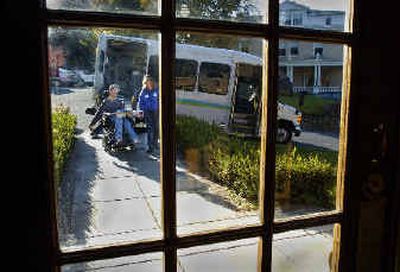STA to cut paratransit service to some riders

About 200 people with disabilities are scheduled to lose their transportation service from the Spokane Transit Authority next year, a loss that some riders say could force them to leave jobs and endanger their independence.
STA currently serves people with disabilities who live within 11/2 miles of its regular bus routes. Starting in January, paratransit vans will only pick up riders who live within three-quarters of a mile of those routes, as allowed under a 1999 lawsuit settlement. The vans come to riders’ homes, and are the most affordable form of transportation available to some.
“That’s the most important thing in my life,” said Brenda Mahler, a paratransit user scheduled to lose service. “It’s taking my life away.”
STA officials say that riders have been warned repeatedly that the change was coming.
“This really is a heart-wrenching issue, particularly for those who did not take proactive measures to get closer to a bus route,” STA Chief Executive Officer Kim Zentz said.
STA’s paratransit van service is used by 5,000 to 6,000 people each year. It costs STA $7.7 million annually, amounting to 21 percent of the agency’s budget.
Of the 200 people eligible for the service who will lose it next year, about 150 have used the vans this year, Zentz said.
Eight people testified against the route changes at an STA board of directors meeting on Wednesday night.
Starting in the 1990s, under guidelines set in the American with Disabilities Act, STA began serving only paratransit users who were within three-quarters of a mile of regular bus routes. After it was sued by the Coalition of Responsible Disabled and other parties under state law, STA agreed in 1999 to extend the boundary to 1½ miles until 2004, Zentz said.
The five-year period was meant to give users time to move within the boundaries, Zentz said. A handbook given to all users of the van service warns about the change, as do letters sent to riders when they become eligible for the service, Zentz said.
But some van riders say the warning was vague at best. They note that the handbook says the service “may” end in 2004, not that it would. Others say that language used by STA when discussing May’s vote to increase sales taxes for the bus system made them feel that the service would not be cut if the measure passed.
“We’re paying taxes,” said Cynthia Glidden, who uses the vans because she is legally blind. “By God, they can service us.”
STA officials say they were consistent in saying that the three-quarters of a mile boundary would be implemented with or without a sales-tax hike.
The 1999 resolution of the lawsuit allows, but does not require, STA to scale back to three-quarters of a mile after five years. However, Zentz said that if STA keeps a boundary different than required in the American with Disabilities Act, it could be forced to serve its entire 370 square-mile tax district with paratransit vans.
STA Board Chairman Kate McCaslin said the Americans with Disabilities Act was passed to ensure equal access. Going beyond three-quarters of a mile would give people with disabilities better public transportation than other riders, she said.
“It’s a matter of fairness,” McCaslin said.
Eugene Sargent, who uses van service once or twice a week, said he would have moved closer to the regular bus routes, but he didn’t think he’d be affected by any STA changes. A March letter from STA told users like Sargent that they would be notified no later than Oct. 1 if they would lose service; instead, the notices were sent in mid-October.
In the meantime, Sargent signed a three-year lease on his mobile home.
“What are you going to do, wait all your life?” Sargent said.